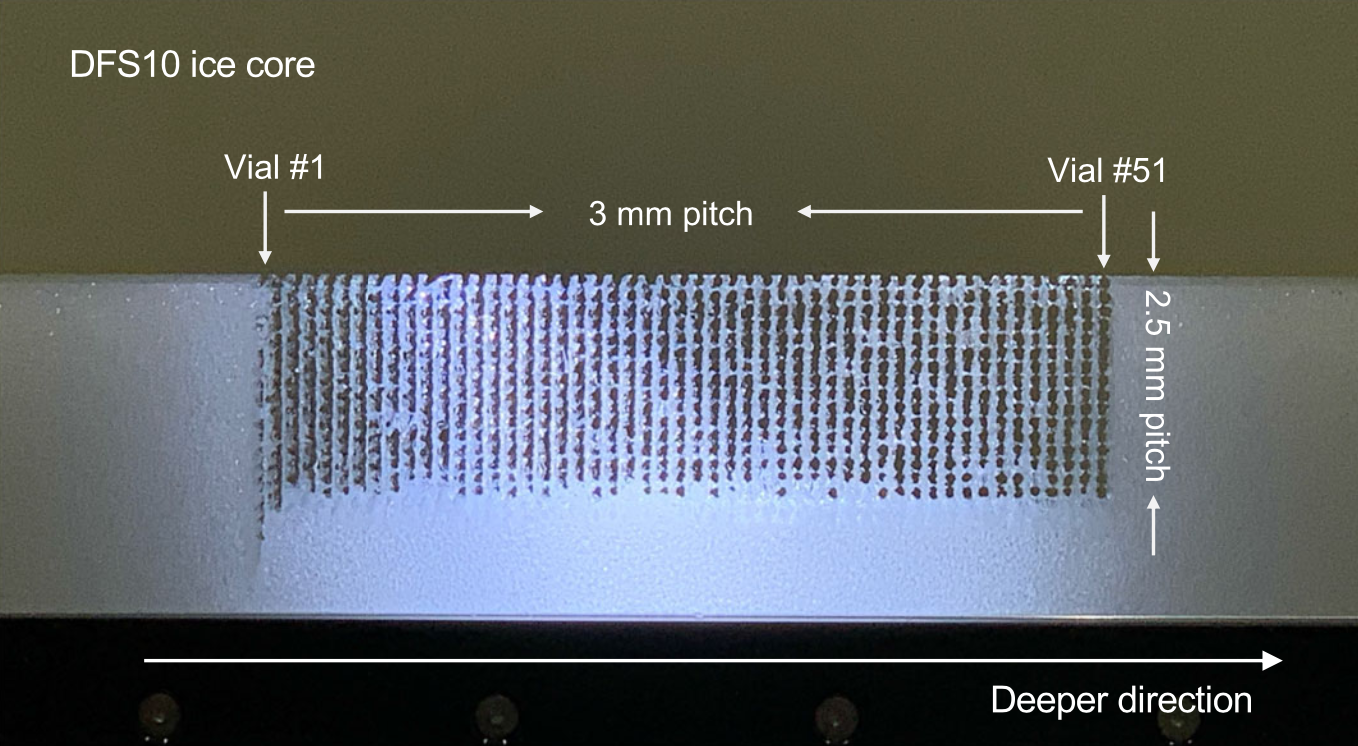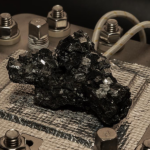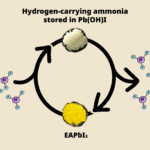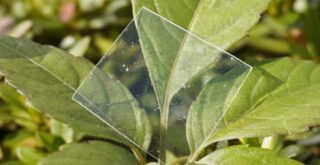Researchers led by Yuko Motizuki from the Astro-Glaciology Laboratory at the RIKEN Nishina Center (RNC) in Japan have developed a new laser-based sampling system for studying the composition of ice cores taken from glaciers. The new system has a 3-mm depth-resolution—about 3 times smaller than what is currently available—meaning that it can detect temperature variations that occurred over much smaller periods of time in the past. The new laser melting sampler, or LMS, is expected to help reconstruct continuous annual temperature changes that occurred thousands to hundreds of thousands of years ago, which will help scientists understand climate change in the past and present. The study was published in the Journal of Glaciology on Sep 19.
Tree rings can tell us how old a tree is, and the color and width of the rings can tell us a little about the local climate during those years. Yearly growth of glaciers can tell us a similar story, but over a much longer period of time. Scientists are studying past changes in climate by analyzing cylindrical ice cores removed from glaciers. By taking samples at regular intervals along the cores, researchers can reconstruct continuous temperature profiles. However, this is impossible with samples taken from deep locations, where annual accumulation has often been compressed to sub-centimeters.

A photograph showing discrete cylindrical holes after sampling (51 vials) a 15 cm-long section of a Dome Fuji shallow ice core (DFS10) drilled in East Antarctica.
Currently there are two standard methods for sampling ice cores. One has a depth-precision of about 1 cm, which means that data from years with less than 1 cm accumulation are lost, and any one-time events that acutely altered climate would be missed. The other method has good depth-precision, but it destroys the part of the sample needed to analyze the water content – the primary way in which scientists calculate past temperatures. The new laser melting sampler overcomes both these problems; it has high depth-precision and does not destroy the critical oxygen and hydrogen isotopes found in water, which are needed to infer past temperature.
The LMS system delivers a laser beam through an optical fiber with a special silver nozzle, and quickly pumps out the liquid sample, eventually depositing it into stainless steel vials. Once the special hardware was assembled, the researchers experimented to optimize three critical parts of the process: the amount of power for the laser, the speed with which to insert the nozzle into the core as the laser melts the ice, and the rate at which the liquid sample is vacuumed out. With the optimization, the researchers could melt the ice as fast as possible, prevent the laser from overheating, and prevent the meltwater from getting too hot, which would destabilize the critical isotopes and prevent correct temperature measurements.
As a proof-of-concept experiment, the team sampled a 15-cm segment of a 50-cm Dome-Fuji shallow ice core, which was taken about a football-field (~92 m) below the ice surface in East Antarctica (see Movie). In one test, they were able to take 51 discrete samples at regular 3-mm intervals along the ice core segment. They measured the stable oxygen and hydrogen isotopes that made up the meltwater extracted from the samples and found that they matched well with those taken by hand segmentation, a process only practical in this research setting. A good match means that the laser-melting process did not ruin the sample, and the inferred temperatures would be accurate.
Motizuki says, “With our laser-melting method, it’s now possible to analyze stable water isotopes at a few-millimeters depth resolution. This will allow researchers to obtain continuous, long-term, annually-resolved temperature profiles, even in deep ice cores collected at low accumulation sites in Antarctica, as well as transient events such as sudden temperature changes which are recorded in them.”
The researchers next plan to use the LMS system, or an upgraded next version, to study climate change related to natural variations in solar activity.
Tree rings can tell us how old a tree is, and the color and width of the rings can tell us a little about the local climate during those years. Yearly growth of glaciers can tell us a similar story, but over a much longer period of time. Scientists are studying past changes in climate by analyzing cylindrical ice cores removed from glaciers. By taking samples at regular intervals along the cores, researchers can reconstruct continuous temperature profiles. However, this is impossible with samples taken from deep locations, where annual accumulation has often been compressed to sub-centimeters.

A photograph showing discrete cylindrical holes after sampling (51 vials) a 15 cm-long section of a Dome Fuji shallow ice core (DFS10) drilled in East Antarctica.
Currently there are two standard methods for sampling ice cores. One has a depth-precision of about 1 cm, which means that data from years with less than 1 cm accumulation are lost, and any one-time events that acutely altered climate would be missed. The other method has good depth-precision, but it destroys the part of the sample needed to analyze the water content – the primary way in which scientists calculate past temperatures. The new laser melting sampler overcomes both these problems; it has high depth-precision and does not destroy the critical oxygen and hydrogen isotopes found in water, which are needed to infer past temperature.
The LMS system delivers a laser beam through an optical fiber with a special silver nozzle, and quickly pumps out the liquid sample, eventually depositing it into stainless steel vials. Once the special hardware was assembled, the researchers experimented to optimize three critical parts of the process: the amount of power for the laser, the speed with which to insert the nozzle into the core as the laser melts the ice, and the rate at which the liquid sample is vacuumed out. With the optimization, the researchers could melt the ice as fast as possible, prevent the laser from overheating, and prevent the meltwater from getting too hot, which would destabilize the critical isotopes and prevent correct temperature measurements.
As a proof-of-concept experiment, the team sampled a 15-cm segment of a 50-cm Dome-Fuji shallow ice core, which was taken about a football-field (~92 m) below the ice surface in East Antarctica (see Movie). In one test, they were able to take 51 discrete samples at regular 3-mm intervals along the ice core segment. They measured the stable oxygen and hydrogen isotopes that made up the meltwater extracted from the samples and found that they matched well with those taken by hand segmentation, a process only practical in this research setting. A good match means that the laser-melting process did not ruin the sample, and the inferred temperatures would be accurate.
Motizuki says, “With our laser-melting method, it’s now possible to analyze stable water isotopes at a few-millimeters depth resolution. This will allow researchers to obtain continuous, long-term, annually-resolved temperature profiles, even in deep ice cores collected at low accumulation sites in Antarctica, as well as transient events such as sudden temperature changes which are recorded in them.”
The researchers next plan to use the LMS system, or an upgraded next version, to study climate change related to natural variations in solar activity.
Further reading
Motizuki et al. (2023) A novel laser melting sampler for discrete, sub-centimeter depth-resolved analyses of stable water isotopes in ice cores. J Glaciol. doi:10.1017/jog.2023.52
Further reading
Motizuki et al. (2023) A novel laser melting sampler for discrete, sub-centimeter depth-resolved analyses of stable water isotopes in ice cores. J Glaciol. doi:10.1017/jog.2023.52










